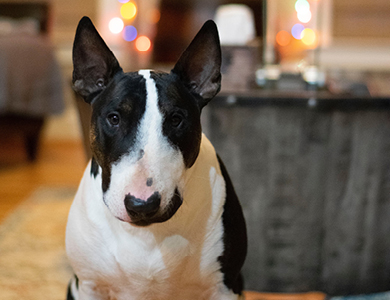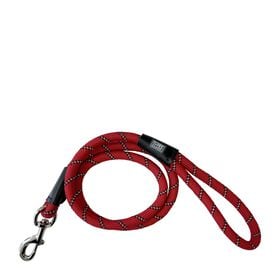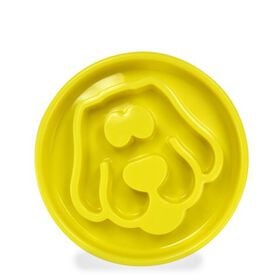Ironically, some of the most amiable dog breeds began their careers as fierce gladiators in blood sports, which is the case for the bull terrier. This affectionate breed often gets bad press because of its association with dog fighting. Even though they are thought to be aggressive, nothing could be further from the truth. Bull terriers make excellent family pets.
Physical appearance
The bull terrier evokes strength. It is muscular, symmetrical and active, has a keen, determined and intelligent expression, and is both bold and courageous. The physical feature that sets this dog apart from all other breeds is undoubtedly its egg-shaped head. Long, strong and deep to the tip of the muzzle, but without any heaviness, its head has no stop at all, giving the dog its characteristic appearance. Its ears are small, thin and placed close together at the top of its head, with the tips straight up. The eyes should be narrow, triangular, well placed in the sockets and as dark as possible, emphasizing its keen expression. The neck is long, very muscular and arched.
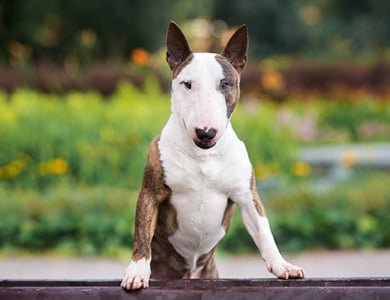
Although the breed standard does not specify a particular height or weight, the breed generally measures 53 to 56 cm (21 to 22 in.) and weighs between 23 and 32 kg (50 and 70 lbs). The standard specifies that the dog should have maximum substance in relation to its height. The miniature bull terrier is a smaller variety, which should not measure more than 35.5 cm (14 in.) at the shoulders. The rest of the breed standard is identical. A bull terrier is classified as either “white” or “coloured.” Although “whites” can have coloured markings, they should be limited to the head. “Coloured” bull terriers can be any colour, or any colour with white, although brindle is preferred. White should never predominate in a “coloured” bull terrier.
Life expectancy and health
Like all breeds, the bull terrier is susceptible to specific health problems. Deafness in one or both ears is a relatively common problem in this breed: nearly 20% of white dogs and approximately 1.5% of coloured dogs are affected. Most conscientious breeders have their puppies undergo BAER (brainstem auditory evoked response) testing between the ages of 7 and 9 weeks. Allergic skin reactions are also common among bull terriers and can even result from insect bites. They are also prone to heart disease, kidney disease and patellar luxation (dislocation of the knee caps). The average life expectancy of a bull terrier is 10 to 14 years.
Energy level and temperament
Bull terriers need moderate daily exercise and good mental and physical stimulation. Long family walks are therefore ideal. The breed was developed for sport as well as to be a gentleman’s companion, and possesses great strength and agility. Participation in canine sports such as obedience, tracking and agility are enjoyable and effective ways to channel the bull terrier’s energy. Solitude, boredom and inactivity can lead to destructive behaviour.
Bull terriers no longer have the characteristics in temperament for which they were bred in the 18th century. Breeders have worked hard to develop a dog with a calm and docile temperament. Bull terriers are affectionate and happy around people, especially children, when properly trained and socialized. One of the breed’s strong characteristics is its tremendous loyalty to humans, especially children, which makes it an excellent family pet.
Maintenance and grooming
Bull terriers shed lightly year round. Weekly brushing with a rubber grooming glove will help keep hair loss to a minimum. During shedding season, once or twice a year, hair loss may be more abundant, and daily brushing is more appropriate. Bull terriers require only occasional bathing. As with all breeds, the nails must be trimmed regularly, since long nails can cause pain and foot problems.
Origins
Around the late 18th century, bull terriers were bred to help control vermin and to fight in blood sports. It’s believed that the breed resulted from crossing the extinct old English bulldog with the white English terrier, a type of now extinct hunting hound, related to the greyhound. This new breed combined the speed and dexterity of the rather lightweight terrier with the tenacity of the bulldog. Various breeds were then used to refine the look we know today, including dalmatian, Spanish pointer and whippet to increase elegance and speed, and borzoi and collie to reduce the stop, giving the bull terrier its egg-shaped head.
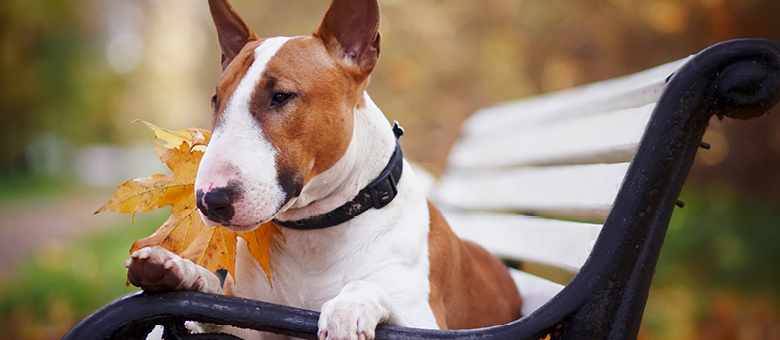
For more information, contact a registered breeder at the Canadian Kennel Club, who can answer all your questions. You can also contact the organization for more information on breeders and various breed clubs in Quebec and elsewhere in Canada.


